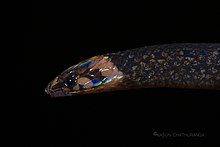Aspidura guentheri
This article includes a list of general references, but it lacks sufficient corresponding inline citations. (May 2019) |
| Aspidura guentheri | |
|---|---|

| |
| Scientific classification | |
| Domain: | Eukaryota |
| Kingdom: | Animalia |
| Phylum: | Chordata |
| Class: | Reptilia |
| Order: | Squamata |
| Suborder: | Serpentes |
| Family: | Colubridae |
| Genus: | Aspidura |
| Species: | A. guentheri
|
| Binomial name | |
| Aspidura guentheri Ferguson, 1876
| |
Aspidura guentheri, commonly known as Günther's rough-sided snake,[2] is a species of snake in the family Colubridae. The species is endemic to Sri Lanka. It is the smallest member of the genus Aspidura.[citation needed]
Etymology
[edit]The specific name, guentheri, is named after the German-born British herpetologist Albert Günther.[2][3]
Geographic range
[edit]A. guentheri is a burrowing snake restricted to the lowlands of Sri Lanka. Localities recorded include Ratnapura, Deniyaya, Yapitikanda, Kandilpana, Kosgama, Kalutara, and Balangoda at altitudes of 100–500 m (330–1,640 ft).[citation needed]
Description
[edit]The head of A. guentheri is indistinct from the neck, and the body is cylindrical. The dorsum is brown, mottled with dark brown. The forehead is dark, and a pale neck band is present. Running down the back are three rows of dark spots, one vertebral row and two lateral rows. The ventral side is light brown.[citation needed]
Scalation
[edit]A. guentheri has the following scalation. The dorsal scales are in 17 rows at midbody. One preocular is present. There are two postoculars, only the upper in contact with the parietal. The ventrals number 101-116, and the subcaudals 19-26.[4]: 338
Ecology
[edit]The diet of A. guentheri comprises mainly earthworms.[citation needed]
Reproduction
[edit]A. guentheri is oviparous.[2] Clutches of one to three eggs are laid.[citation needed]
References
[edit]- ^ Wickramasinghe, L.J.M. (2021). "Aspidura guentheri". IUCN Red List of Threatened Species. 2021: e.T197193A123311982. doi:10.2305/IUCN.UK.2021-3.RLTS.T197193A123311982.en.
- ^ a b c Species Aspidura guentheri at The Reptile Database www.reptile-database.org.
- ^ Beolens, Bo; Watkins, Michael; Grayson, Michael (2011). The Eponym Dictionary of Reptiles. Baltimore: Johns Hopkins University Press. xiii + 296 pp. ISBN 978-1-4214-0135-5. (Aspidura guentheri, pp. 110-111).
- ^ Smith, MA (1943). The Fauna of British India, Ceylon and Burma, Including the Whole of the Indo-Chinese Sub-region. Reptilia and Amphibia. Vol. III.—Serpentes. London: Secretary of State for India. pp. xii + 583.
Further reading
[edit]- Boulenger GA (1890). The Fauna of British India, Including Ceylon and Burma. Reptilia and Batrachia. London: Secretary of State for India in Council. (Taylor and Francis, printers). xviii + 541 pp. (Aspidura guentheri, p. 290).
- Boulenger GA (1893). Catalogue of the Snakes in the British Museum (Natural History). Volume I., Containing the Families ... Colubridæ Aglyphæ, part. London: Trustees of the British Museum (Natural History). (Taylor and Francis, printers). xiii + 448 pp. + Plates I-XXVIII. (Aspidura guentheri, p. 312 + Plate XX, figure 3).
- Ferguson W (1876). "Description of a New Snake of the Genus Aspidura ". Proc. Zool. Soc. London 1876: 819-820 (Aspidura guentheri, new species).
- Wall F (1921). Ophidia Taprobanica or the Snakes of Ceylon. Colombo, Ceylon [Sri Lanka]: Colombo Museum. (H.R. Cottle, Government Printer). xxii + 581 pp. (Aspidura guentheri, pp. 208–209).
External links
[edit]- "Aspidura guentheri Ferguson 1876 - BiologyBrowser". Archive.is. 2 July 2014. Archived from the original on 2 July 2014. Retrieved 20 May 2019.

